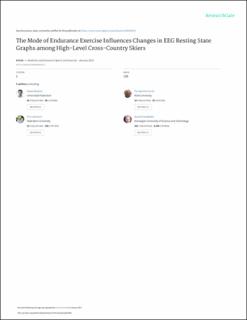| dc.contributor.author | Büchel, Daniel | |
| dc.contributor.author | Torvik, Per Øyvind | |
| dc.contributor.author | Lehmann, T.I.M. | |
| dc.contributor.author | Sandbakk, Øyvind Bucher | |
| dc.contributor.author | Baumeister, Jochen | |
| dc.date.accessioned | 2024-04-11T12:50:21Z | |
| dc.date.available | 2024-04-11T12:50:21Z | |
| dc.date.created | 2023-06-12T12:28:16Z | |
| dc.date.issued | 2023 | |
| dc.identifier.citation | Medicine & Science in Sports & Exercise. 2023, 55 (6), 1003-1013. | en_US |
| dc.identifier.issn | 0195-9131 | |
| dc.identifier.uri | https://hdl.handle.net/11250/3126139 | |
| dc.description.abstract | Purpose Acute bouts of exercise influence the communication and organization of brain networks, with exercise intensity and volume regarded as key moderators. However, differences in coordination demands and limb involvement between exercise modes may also affect the communication and organization of brain networks after exercise and should be considered additionally. This study aimed to investigate the effect of mode on exercise-induced changes in electroencephalogaphy (EEG) resting-state networks comparing running (RUN) and cross-country skating (XC). Methods Fifteen male, highly trained participants were tested for peak oxygen uptake (V̇O2peak) during RUN (65.3 mL·min−1·kg−1) and XC (63.5 mL·min−1·kg−1) followed by incremental protocols at 50%, 70%, and 90% of speed at V̇O2peak in both modes on the treadmill. After each exercise bout, 5-min resting-state EEG assessments using 64 channels were performed. Upon graph theory, small world index (SWI), clustering coefficient (CC), and path length (PL) were assessed in theta, alpha-1 and alpha-2 frequency bands. Repeated-measures ANOVA was applied to analyze the influence of exercise intensity and mode on modulations in brain network efficiency. Results Main effects of mode on SWI (P = 0.047), CC (P < 0.001), and PL (P = 0.031) in the alpha-2 network indicated stronger modulations in network efficiency after XC. Main effects of exercise intensity in the theta network indicated modulated SWI (P < 0.001), CC (P < 0.001), and PL (P = 0.003) after exercise at 90% of V̇O2peak speed. Physiological outcomes (heart rate, blood lactate concentration, and rating of perceived exertion) were influenced by intensity solely. Conclusions The present study demonstrates that an acute bout of coordinatively challenging endurance exercise may affect brain networks differently compared with running. Future studies may consider exercise mode as a potential moderator in the acute interaction between exercise and the brain. | en_US |
| dc.description.abstract | The Mode of Endurance Exercise Influences Changes in EEG Resting-State Graphs among High-Level Cross-Country Skiers | en_US |
| dc.language.iso | eng | en_US |
| dc.publisher | Lippincott, Williams & Wilkins | en_US |
| dc.rights | Navngivelse 4.0 Internasjonal | * |
| dc.rights.uri | http://creativecommons.org/licenses/by/4.0/deed.no | * |
| dc.title | The Mode of Endurance Exercise Influences Changes in EEG Resting-State Graphs among High-Level Cross-Country Skiers | en_US |
| dc.title.alternative | The Mode of Endurance Exercise Influences Changes in EEG Resting-State Graphs among High-Level Cross-Country Skiers | en_US |
| dc.type | Peer reviewed | en_US |
| dc.type | Journal article | en_US |
| dc.description.version | acceptedVersion | en_US |
| dc.rights.holder | Copyright © 2023 by the American College of Sports Medicine | en_US |
| dc.source.pagenumber | 1003-1013 | en_US |
| dc.source.volume | 55 | en_US |
| dc.source.journal | Medicine & Science in Sports & Exercise | en_US |
| dc.source.issue | 6 | en_US |
| dc.identifier.doi | 10.1249/MSS.0000000000003122 | |
| dc.identifier.cristin | 2153751 | |
| cristin.ispublished | true | |
| cristin.fulltext | postprint | |
| cristin.qualitycode | 2 | |

